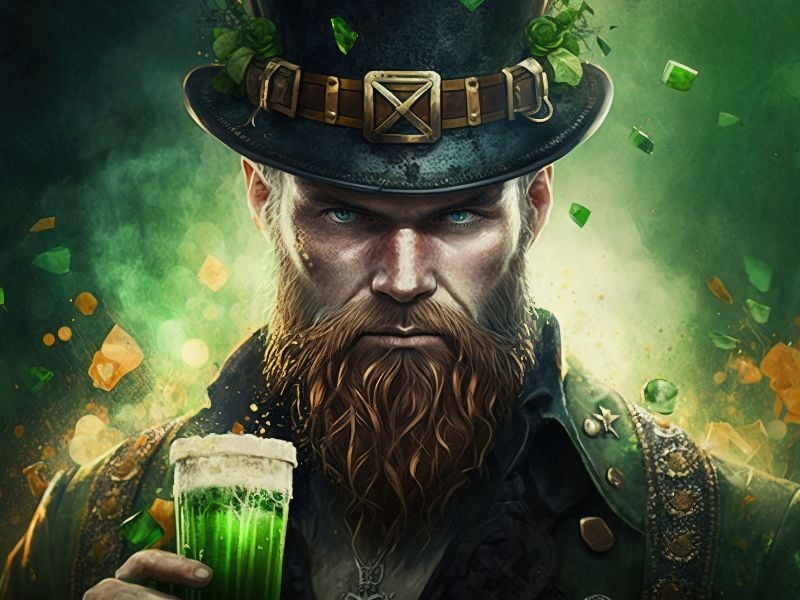I am here to tackle another divisive topic on my perpetual quest to get canceled. If my sarcasm wasn’t detectable, please make a note that it is, indeed, present.

Historically, St. Patrick’s Day has meant little more to me than a reason to wear my favorite color and down beverages resembling kryptonite. However, when the topic of St. Patrick’s Day comes up in pagan spheres, it’s always an interesting discussion. I will get to the reasons for this shortly, but let’s start at the beginning.
Who Was St. Patrick?
In short, St. Patrick is known as the patron saint of Ireland—despite not being of Irish descent. Moreover, he was never officially canonized by the Catholic Church. That said, this has more to do with the era than him not meeting the criteria.
St. Patrick was born in Britain to wealthy parents in approximately the 4th century, and it’s widely believed that he died on March 17. In his teenage years, he was kidnapped by a group of Irish raiders and held captive for six years before escaping. It’s suggested that during his time in captivity, he became deeply religious and, thus, planted the seeds for the holy figure we know today.
According to History’s article, “Who Was St. Patrick?” in his own writings, he documented that he began to speak with a voice that he believed to be god. After his escape to Britain, it’s said that he had a second revelation that encouraged him to return to Ireland. In this vision, he was to return to minister to the existing Christians in Ireland and convert those who had not adopted Christianity as their religion. As such, after completing religious training, he returned to Ireland as a missionary and spent the rest of his life preaching the Gospel and establishing churches and monasteries.
Due to his familiarity with the Irish language and culture, he was able to implement Christianity while maintaining some of the existing structures. One of the most notable examples of this is the Celtic cross which incorporates the sun in the center, as the natives of Ireland were accustomed to worshiping nature.
Snakes of Ireland
It is this very conversion that can stir up deep emotions in pagans today. In any case, there is merit in being disappointed in the loss of history that was the product of Christianization. But nonetheless, this dismay is further compounded by the myth of the Snake of Ireland.
In this myth, St. Patrick drove the snakes of Ireland from the land into the sea. That said, it must be noted that Ireland is an island, and there’s minimal proof that snakes ever inhabited the land in the first place. The National Geographic’s article, “Snakeless in Ireland: Blame Ice Age, Not St. Patrick,” reports that remnants of snakes have never been found on the island. Regardless, this is not what people typically take exception with.
According to some sources, the “Snakes of Ireland” were a euphemism for pagans. Thus, by ridding the island of snakes, he was ridding the island of paganism. Some accounts say that the Celtic Druids had tattoos of snakes, and to some, this further solidified the comparison. However, evidence of this is scarce.
Whether or not driving the snakes from Ireland was a metaphor for displacing the Druids is of much debate. Yet, one thing is for certain, and that is that we can not credit St. Patrick with the miraculous feat of ridding the island of actual snakes. We owe those accolades to nature itself.
Celebrations
Originally, St. Patrick’s Day was celebrated in a religious manner by attending church services and enjoying a feast with friends and family. The holiday, however, became more secular and festive as Irish immigrants settled in other parts of the world.
The first St. Patrick’s Day parade was held in St. Augustine, Florida in 1601, and subsequently, parades and celebrations spread throughout the United States and other countries with Irish populations. These festivities often feature shamrocks, leprechauns, symbols of Irish culture, and the color green.
Green
Despite St. Patrick’s knights wearing a shade of blue dubbed “St. Patrick Blue,” the holiday is largely associated with the color green in modern times. This was a concept that was introduced later, and it’s frequently attributed to Ireland’s moniker “Emerald Isle,” but it’s likely deeper than that. Some sources say that this is due to the use of the color to represent Irish independence, and it’s worth noting that the color is also found on the country’s flag alongside white and orange.
Clovers
Another staple of the celebrations is clovers. It’s said that St. Patrick used these clovers to portray the holy trinity. In modern times, clovers—particularly four-leaf clovers—have become a symbol of wealth and good fortune. Though not a part of the traditional symbolism, finding a four-leaf clover in the wild is thought to ensure prosperity for the lucky individual.
Leprechauns
The most intriguing part of the celebration to me is the use of Leprechauns. Per History’s article, “St. Patrick’s Day Traditions,” the Irish name for them is “lobaircin,” which means “small-bodied fellow.” These mischievous creatures are kin to the fae and are often found in Irish folklore. There are several myths surrounding Leprechauns, such as hiding pots of gold at the end of rainbows. There’s also the myth of finding a Leprechaun, which would then grant you three wish. Again, much like the clovers, Leprechauns are symbolic of good fortune.
Pagans and St. Patricks Day
Despite the secularization of modern-day St. Patrick’s Day, this is a festivity that some pagans choose to sit out. They may choose to wear a serpent pendant in protest of the holiday. At this point, I must note that I almost exclusively where a serpent necklace, so if you happen to see me on St. Patrick’s Day—this is not an official statement.
However, on the other side of the coin, some with Celtic ancestry may use this holiday as a time to connect with their ancestors and heritage. This can be a great time for exploring Irish folktales and mythology in more depth.
Others may even participate in the festivities simply to celebrate St. Patrick’s death. Regardless, the occasion does make for a fine excuse to drink green concoctions and participate in some merriment. The choice is yours.
















